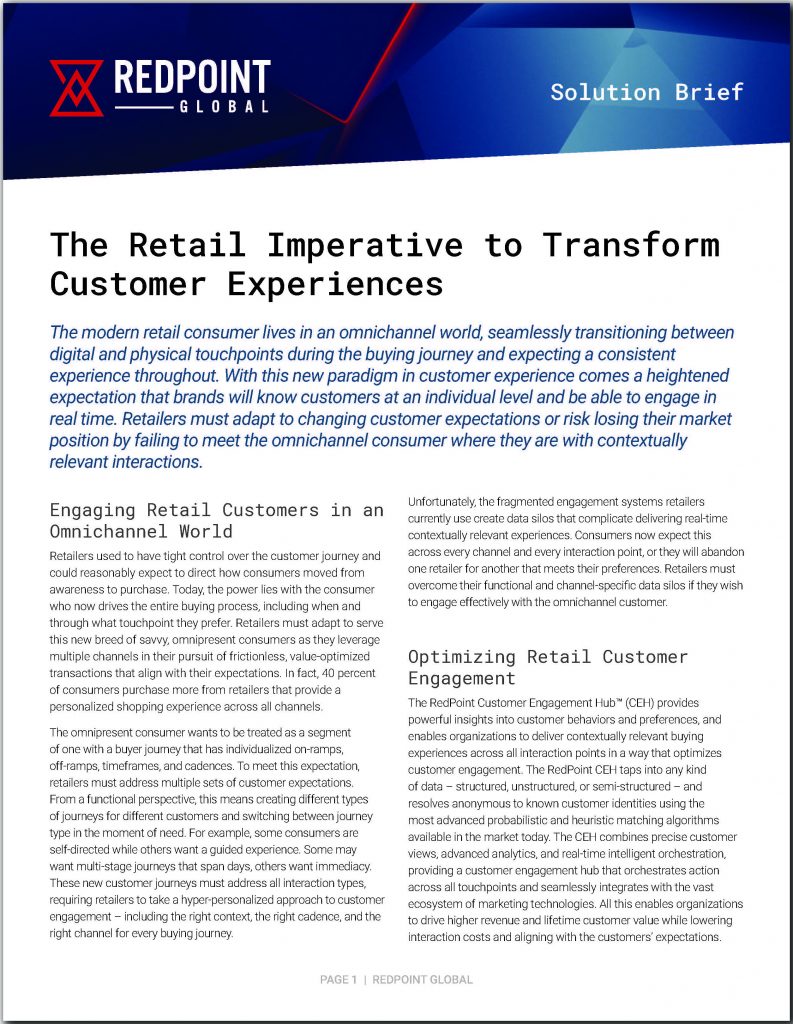 Amazon, long a pioneer in the personalization of the consumer digital experience, is cementing a new reputation as a serious player in the physical retail space. Why is the company that revolutionized e-commerce investing billions in physical retail, including Amazon Books, the purchase of Whole Foods, and the recent news that it is launching its own line of physical grocery stores?
Amazon, long a pioneer in the personalization of the consumer digital experience, is cementing a new reputation as a serious player in the physical retail space. Why is the company that revolutionized e-commerce investing billions in physical retail, including Amazon Books, the purchase of Whole Foods, and the recent news that it is launching its own line of physical grocery stores?
The recent Shoptalk conference in Las Vegas shed some answers. The intertwining of the physical and digital shopping experience was top of mind for many of the more than 8,000 Shoptalk attendees, which included nearly 300 speakers and more than 100 sessions devoted to the future of retail. During the “What’s Next for Voice Retail?” session, David Isbitsky, Chief Evangelist for Amazon Alexa, drove home the importance of speed as a facilitator of personalization. Devices and screen time, he said, slow consumers down as they seamlessly move between physical and digital locations, whereas voice technology that recognizes a consumer’s history, preferences, and intent delivers greater value by more quickly personalizing the experience.
New store innovations and brand realignments – including Gap splitting off the Old Navy business and Walmart.com – were other big Shoptalk topics, but not necessarily because they foretell the decline of traditional brick-and-mortar retail. Rather, according to Brendan Witcher, analyst for Forrester Research, they’re reflective of a need for retailers to be more data-driven in providing a relevant, personalized experience across channels. Amazon may be successful where others have failed because it is better at connecting with customers on a personal level. “When a store closes it is not a sign that there’s a store problem. It’s a sign that there’s a brand problem,” Witcher said in an interview with Total Retail.
Focusing on a store closing, he said, is to focus on the wrong problem. Becoming more data-driven to create a personal customer experience can turn the physical store from a liability into an asset. In a session titled “Customer Data and Brand-Building”, Witcher moderated a session with executives from Lilly Pulitzer, GUESS? Inc., and Modell’s Sporting Goods who provided examples of how they are using insights collected from customer data to create new and engaging experiences for shoppers, in both the physical and digital realms.
Meet Customers Anywhere in Their Journey
This blending of physical and digital channels into a seamless, “always-on” experience is the evolution of retail, and the prioritization of customer experience throughout an omnichannel journey renders many traditional marketing strategies obsolete.
Retail marketers without the deep pockets of an Amazon face several key challenges in competing on customer experience, especially with the bar continuing to rise at a breakneck pace. One challenge is siloed customer data across the enterprise, which makes it exceedingly difficult for marketing to track and manage an omnichannel customer journey. Resource constraints compound this challenge, limiting marketer’s ability to access data, rapidly change customer journeys, and tune programs to hit revenue goals.
To keep pace with retail’s evolution and differentiate on a personalized experience, marketers must overcome data limitations and move toward zero segment marketing, which treats each consumer differently according to their buying patterns, preferences, and intent across multiple devices and channels.
A one-size-fits-all approach with limited demographic segmentation on a channel-by-channel basis is not tenable when customers expect a personalized experience that spans the digital and physical worlds. Zero segment marketing provides a personalized experience across all channels and devices, and goes further to recognize each interaction as contributing to a customer’s lifetime value, which in turns deepens each future engagement. It adds relevancy to each touchpoint.
Reaching this breakthrough capability to optimize engagement across channels at scale requires automation and intelligence. Getting started isn’t as difficult as many retail marketers are led to believe.
Accelerate to Personalized Engagements
Delivering personalization at scale across multiple channels requires, first and foremost, a single view of the customer. A single view that combines all customer data from first-party, second-party, and third-party sources is the first step for a retail marketer to recognize a consumer across channels and gain insights into a specific customer’s buying patterns and preferences.
When advanced analytics are applied to an accurate and accessible unified view of the customer, marketers can easily determine a next-best action and orchestrate dynamic customer journeys across all touchpoints. With algorithms to guide recommendations based on metrics such as social profiles, lifetime value, and contact history, retail marketers ensure continually optimized engagements.
While many large retailers implement custom solutions with tools like Redpoint Customer Engagement Hub™, there is also an option that has helped some retailers jump into the personalization space with a solution that more immediately fits their needs. Redpoint SaaS Delivery Option for Retail is a packaged solution that provides growth-oriented retail marketers with these capabilities with a reduced time to value, with implementation measured in weeks rather than months or years. Built on the Microsoft Azure cloud platform, Redpoint SaaS Delivery Option for Retail helps retailers achieve value by offering turnkey preconfigured marketing templates, reports, and channels, including email, mobile, social, websites, and direct mail.
Robust offerings allow marketers to easily capture customer preferences and determine how to react in real time based on anonymous and known customer profiles. An underlying retail data model includes every attribute needed for targeted campaign selections and segmentation for personalized engagement.
An On-Ramp to Personalization at Scale
To keep pace with today’s always-on consumer, retail marketers must recognize a customer at every stage of potentially multiple customer journeys. To provide a personalized experience across engagements and channels at scale is virtually impossible to do manually, especially for a retail marketing organization faced with limited resources and siloed customer data. A packaged solution that eliminates those barriers and automates the delivery of contextually relevant offers and messages provides a quick on-ramp for retail marketers to optimize engagements and compete on customer experience.
RELATED ARTICLES
Clienteling and the Personalized In-Store Experience
Evolution of the Customer Experience and the Role of Data
How to Meet the Connected Customer’s Expectations

